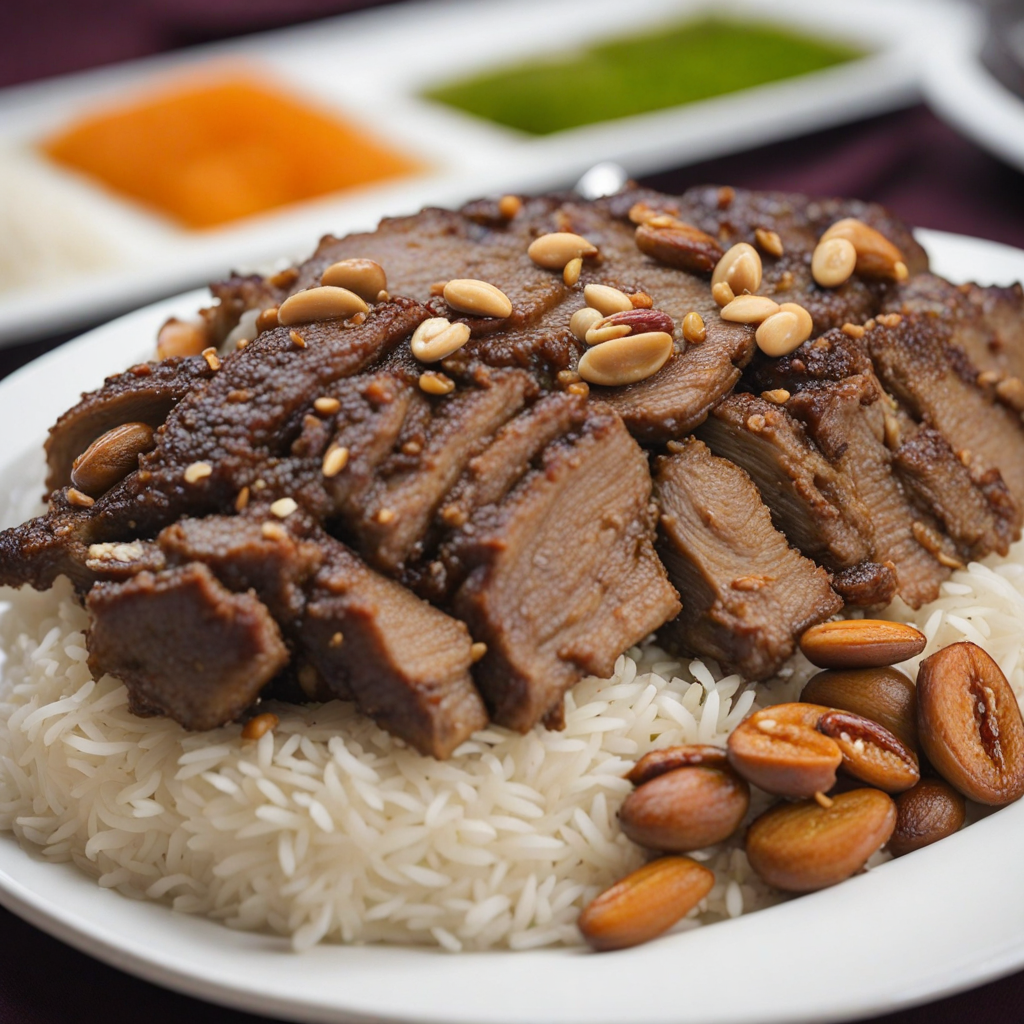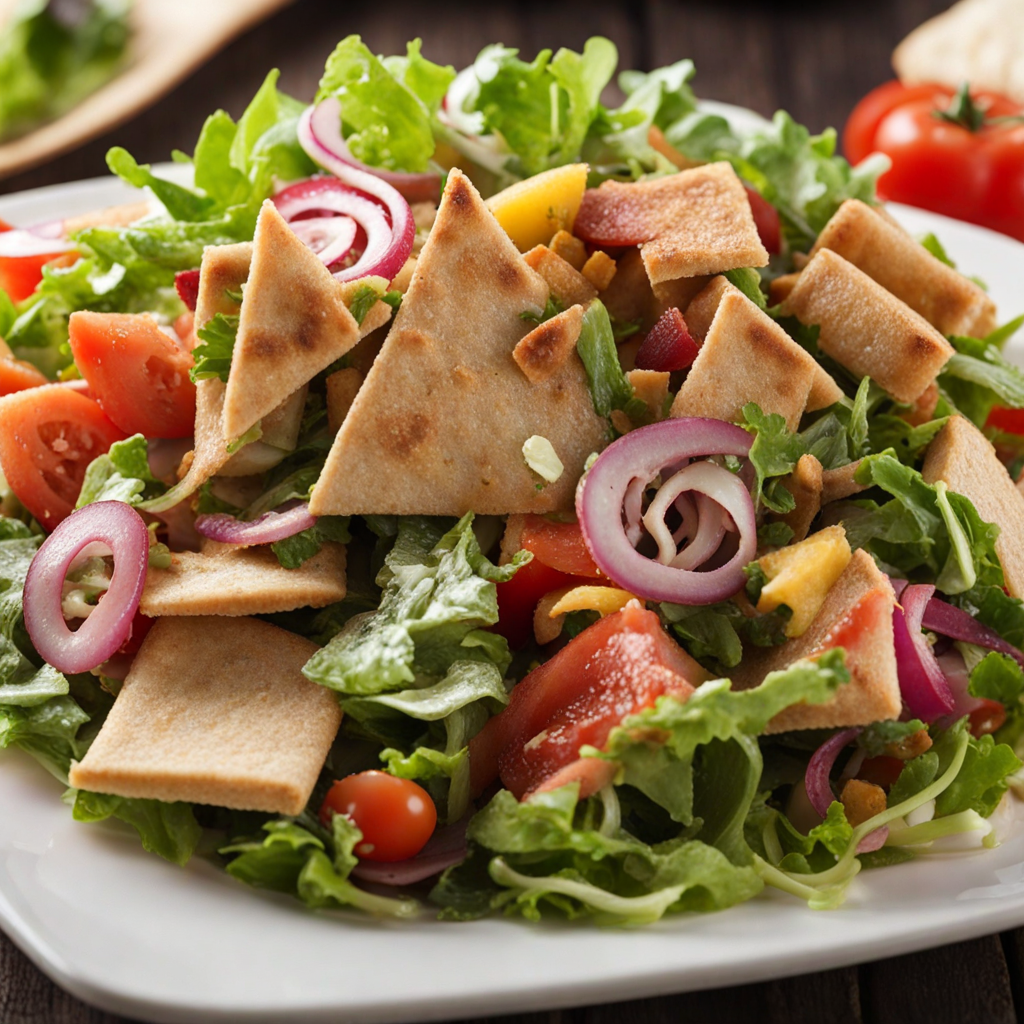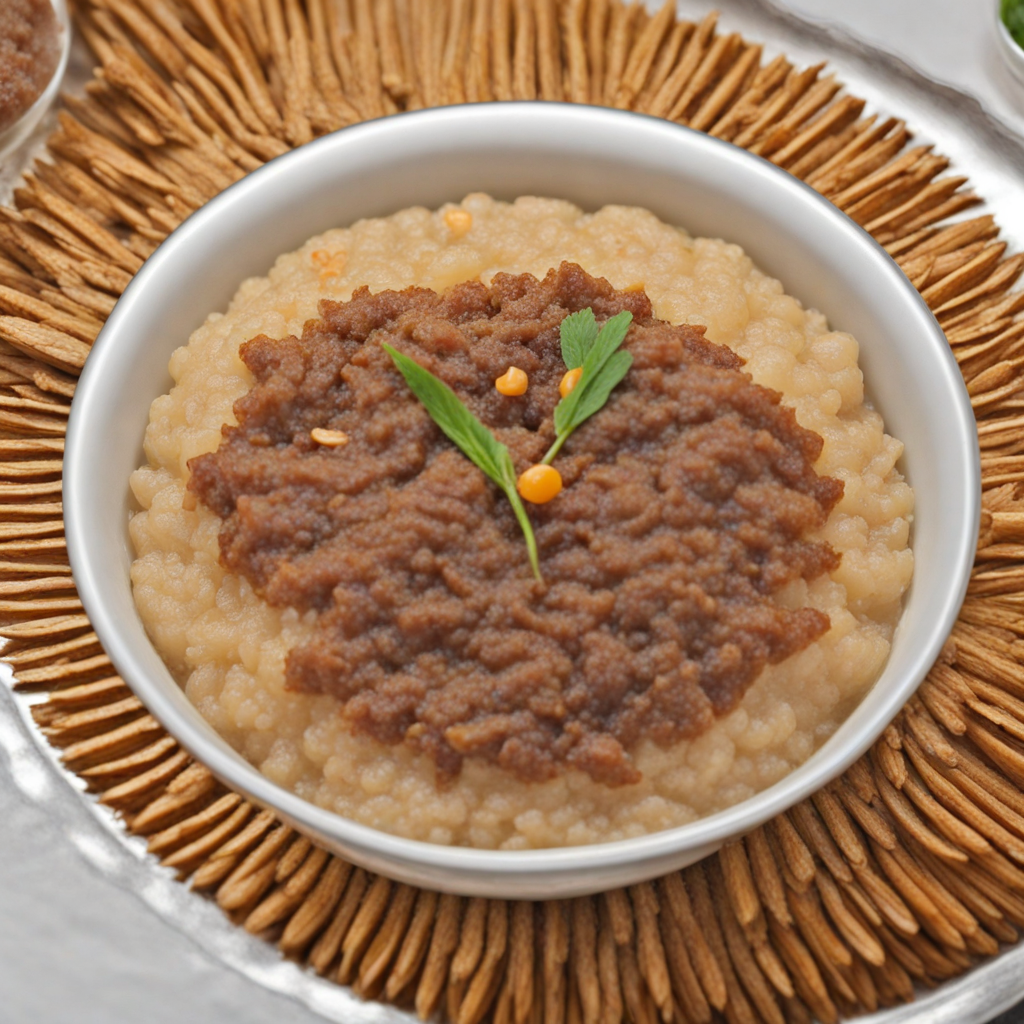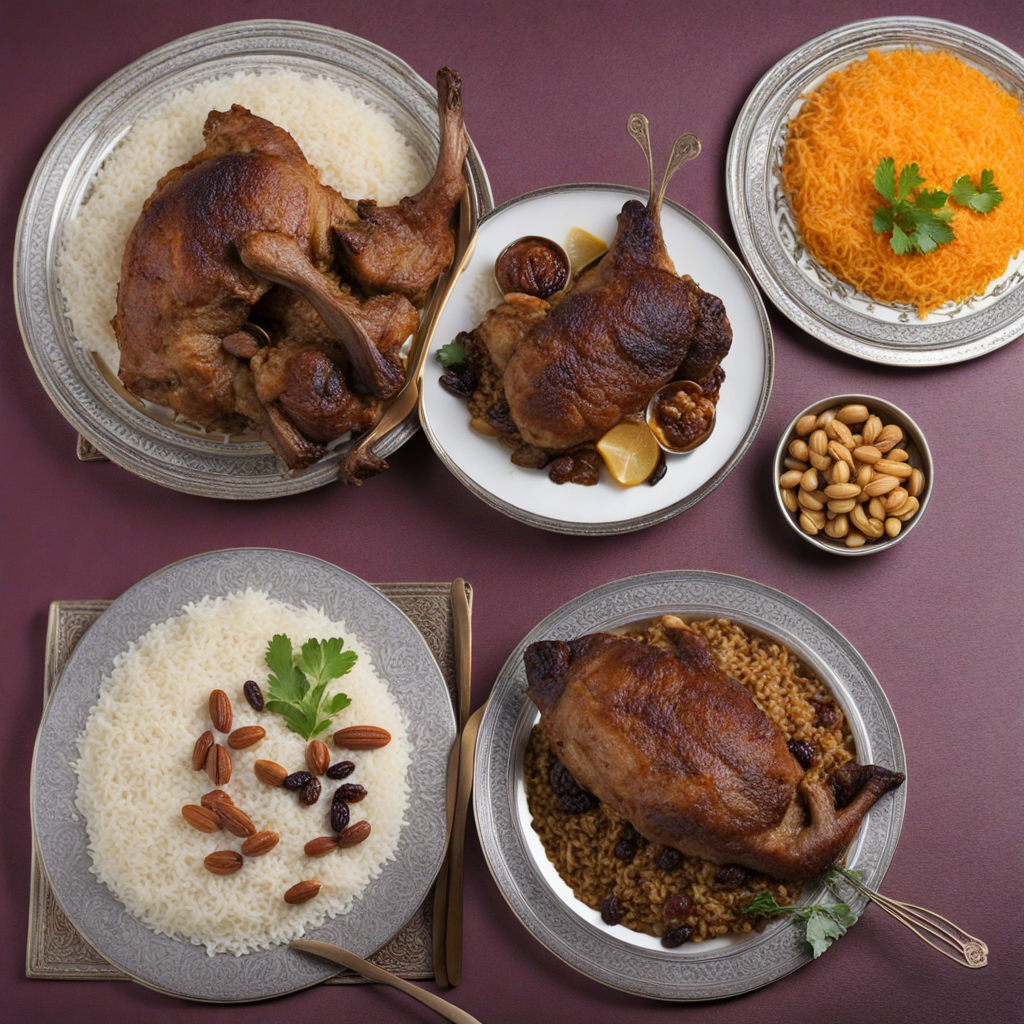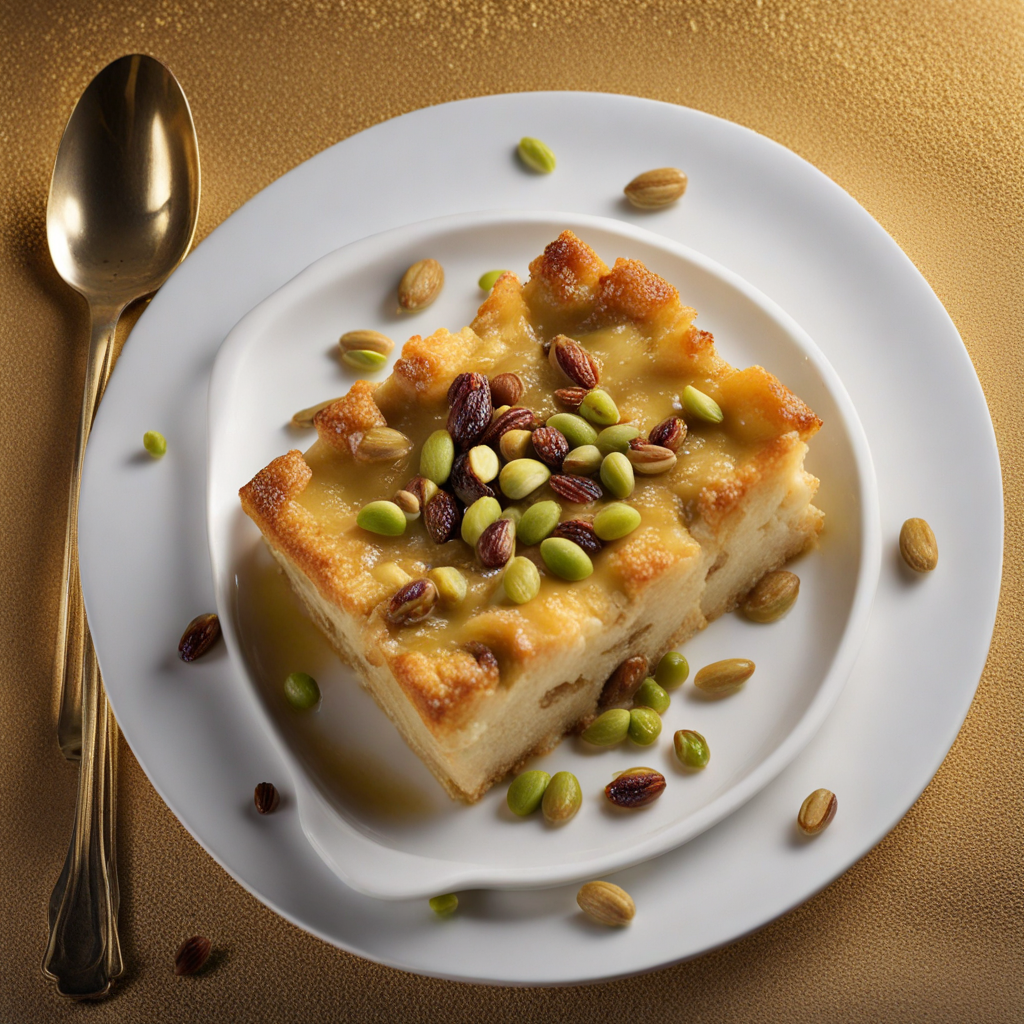Ghuzi
Ghuzi is a traditional Qatari dish that beautifully showcases the rich flavors and culinary heritage of Qatar. At its core, Ghuzi consists of tender, marinated lamb or goat that is slow-cooked to perfection, ensuring the meat is succulent and packed with flavor. The meat is typically seasoned with a blend of spices such as cumin, coriander, and cardamom, which infuse it with warmth and depth. The dish is often served over a bed of fragrant basmati rice, which is cooked with the meat's juices, allowing the rice to absorb all the savory notes, creating a harmonious balance of taste and texture. What truly sets Ghuzi apart is the medley of ingredients that accompany it. The dish is often garnished with toasted almonds, pine nuts, and raisins, adding a delightful contrast of crunch and sweetness to the savory elements. Additionally, fried onions and fresh herbs, like parsley or mint, are sprinkled on top, elevating the dish's aromatic profile. The combination of these textures and flavors makes each bite of Ghuzi a rewarding experience, showcasing the complexity and richness of Qatari cuisine. Ghuzi is more than just a meal; it is a cultural experience often enjoyed during celebrations, family gatherings, and special occasions. Traditionally served on a large platter, it invites communal dining, where friends and family can share in its deliciousness. As you dive into this dish, you’ll not only savor a unique blend of spices and ingredients but also partake in a tradition that embodies hospitality and togetherness in Qatari culture. Discovering Ghuzi is a delightful journey into the heart of Qatar's culinary art.
How It Became This Dish
The History of غوزي (Ghozi) in Qatar The culinary landscape of Qatar is rich and diverse, shaped by centuries of trade, cultural exchange, and the unique geographic environment of the Arabian Peninsula. One of the most cherished dishes in Qatari cuisine is غوزي (Ghozi), a traditional rice and meat dish that embodies the spirit of Qatari hospitality and the country’s deep-rooted culinary heritage. #### Origin and Historical Context Ghozi's origins are anchored in the Bedouin lifestyle, where nomadic tribes relied heavily on the resources available in their arid environment. Traditionally, the dish features marinated lamb or goat, seasoned with a blend of spices and herbs, layered over fragrant rice cooked with a rich broth. While the exact timeline of Ghozi's creation is difficult to pinpoint, it is believed to have emerged over a century ago, influenced by the culinary practices of neighboring regions in the Gulf. The dish's name, "Ghozi," derives from the Arabic word for "stuffed," often referring to the method of preparing the meat, which is sometimes stuffed with rice, nuts, and spices before being slow-cooked. This reflects the resourcefulness of the Bedouins, who transformed simple ingredients into a feast fit for gatherings and celebrations. #### Cultural Significance Ghozi is more than just a meal; it is a symbol of Qatari hospitality and tradition. In Qatari culture, food serves as a means of bringing people together, and Ghozi is often the centerpiece of family gatherings, weddings, and special occasions. The preparation of the dish can be a communal activity, with family members participating in marinating the meat, cooking the rice, and setting the table. The dish is traditionally served on large platters, encouraging communal eating, which fosters a sense of unity and connection among diners. It is common for guests to be served Ghozi first, illustrating the importance of hospitality in Qatari culture. The layering of flavors—from the tender meat to the spiced rice—mirrors the mingling of different cultures and traditions over centuries, showcasing how food can be a reflection of society. #### Development Over Time As Qatar underwent significant transformations during the 20th century, particularly with the discovery of oil in the 1930s, its culinary scene evolved. The influx of expatriates and the globalization of food trends introduced new ingredients and cooking techniques, but Ghozi remained a steadfast staple in Qatari households. In contemporary Qatari cuisine, Ghozi has taken on various forms, with chefs experimenting with flavors and presentation while preserving the essence of the traditional dish. For instance, while the classic version emphasizes the use of lamb or goat, modern interpretations might incorporate chicken or even vegetarian alternatives, catering to diverse palates and dietary preferences. The growing popularity of Ghozi has also led to its inclusion in international food festivals and exhibitions, where it is presented as a hallmark of Qatari gastronomy. Restaurants in Doha and beyond have embraced the dish, offering their unique takes on Ghozi while remaining true to its roots. This has not only contributed to the dish's popularity but has also fostered an appreciation for Qatari culture among tourists and expatriates. #### Ingredients and Preparation The preparation of Ghozi is an art form in itself, requiring time and attention to detail. The process often begins with marinating the meat in a mixture of yogurt, spices such as cardamom, cumin, and coriander, and sometimes saffron, which adds a distinctive flavor and rich color. After marinating for several hours or overnight, the meat is cooked slowly, allowing it to become tender and infused with the spices. The rice is another critical component, typically basmati, known for its long grains and aromatic qualities. It is cooked separately in the broth of the meat, absorbing the flavorful juices and spices. Some variations of Ghozi include the addition of nuts, raisins, or fried onions, which add texture and depth to the dish. The final presentation of Ghozi is indeed a feast for the eyes. The cooked meat is often placed atop a mound of rice, garnished with nuts and herbs, and served with a side of tangy salad or yogurt. This visual appeal, combined with the aromatic spices, creates an inviting atmosphere that encourages diners to indulge. #### Contemporary Relevance In recent years, Ghozi has gained recognition beyond Qatar, becoming a dish that represents the broader Gulf region. As Qatar prepares to host international events, such as the FIFA World Cup 2022, the culinary heritage embodied by Ghozi has become a focal point for promoting Qatari culture to a global audience. Culinary programs and workshops have emerged, teaching both locals and visitors how to prepare traditional dishes like Ghozi. This not only preserves the heritage but also inspires a new generation to appreciate their cultural roots. Social media has also played a significant role in showcasing Ghozi, with food bloggers and influencers posting their experiences of trying the dish, sparking interest and curiosity among food enthusiasts worldwide. #### Conclusion Ghozi is more than just a dish; it is a celebration of Qatari identity, history, and hospitality. Its evolution over time reflects the adaptability and resilience of Qatari culture, as it embraces both tradition and innovation. As Qatar continues to develop and engage with the world, Ghozi will undoubtedly remain a cherished symbol of the nation's culinary heritage, inviting all to partake in its rich flavors and history. Whether served at a family gathering or a grand celebration, Ghozi embodies the spirit of togetherness, warmth, and the timeless art of sharing food.
You may like
Discover local flavors from Qatar


